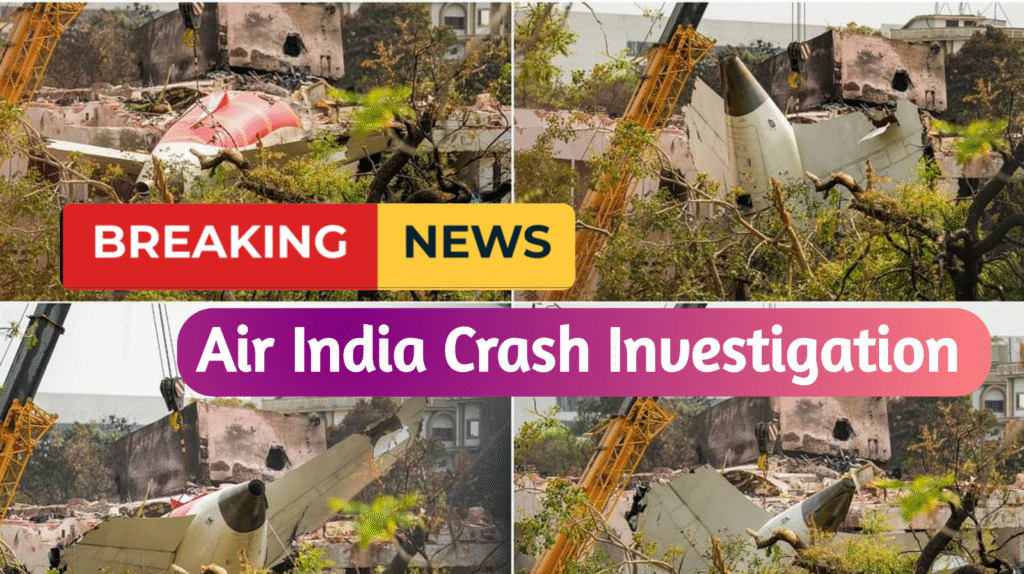Ahmedabad : In the aftermath of the tragic Air India Dreamliner crash near Ahmedabad, which claimed 241 lives out of 242 passengers on board, a mobile video shot by a local teenager has emerged as a potential breakthrough in the investigation. As authorities examine every possible angle, experts believe this footage could offer critical insights into the cause of the catastrophe.
PM’s Principal Secretary Reviews Crash Site and Hospital
Prime Minister Narendra Modi’s Principal Secretary, P.K. Mishra, conducted an on-ground inspection of the crash site in Ahmedabad on Sunday. He also visited the Civil Hospital where the sole survivor, 32-year-old Vishwas Kumar Ramesh, is undergoing treatment. The senior official assured that no stone will be left unturned in the ongoing probe, being conducted by multiple aviation regulatory bodies.
Aryan’s Video May Hold Answers
The video in question was captured by Aryan Asari, a 12th-grade student who was staying with his father in Ahmedabad’s Meghaninagar area. Out of mere curiosity, Aryan filmed the low-flying aircraft from his rooftop. He later sent the video to his father, a retired army man currently employed as a metro security guard, before it went viral across social media platforms.
According to experts, Aryan’s footage captures a crucial few seconds showing the aircraft’s condition just before the crash. Investigators now believe this video could help validate or challenge existing theories about the sequence of technical failures that occurred mid-flight.
Possible RAT Deployment Points to Emergency
One of the striking observations from the video is the visible deployment of the Ram Air Turbine (RAT)—a small wind-driven emergency generator that activates when both engines fail or when there’s a complete electrical power loss.
This observation aligns with the testimony of survivor Vishwas Kumar, who mentioned a loud explosion followed by cabin lights going off. “Just before the crash, a green light flickered inside the cabin and the pilot made a distress (Mayday) call,” he told investigators from his hospital bed.
If confirmed, the RAT deployment could signify a complete dual-engine shutdown—an exceptionally rare occurrence in aviation history, particularly for a twin-engine Dreamliner operating under routine conditions.
Delays in Refueling Raise New Questions
A source at Sardar Vallabhbhai Patel International Airport has revealed that the aircraft took an unusually long 42 minutes to refuel—much longer than the average turnaround time for international flights. While some aviation experts maintain this could be routine, others believe it points to possible issues with the fuel system or ground equipment calibration.
With the Black Box and Flight Data Recorder already recovered, authorities are cross-verifying time-stamped data with footage and witness statements to narrow down the cause.
Could the Dual Engine Failure Be Explained?
Initial assumptions among aviation analysts dismissed the likelihood of both engines failing simultaneously. However, the current evidence suggests otherwise. If RAT was indeed deployed mid-air, it indicates either a total electrical failure, hydraulic system collapse, or a catastrophic double engine shutdown—all of which demand emergency protocols.
Sources close to the Directorate General of Civil Aviation (DGCA) say that the explosion may have been caused by damage to the lower hatch of the aircraft, possibly triggering the automatic deployment of RAT.
Issues May Have Started Right After Takeoff
Based on flight tracking data and video evidence, it appears the aircraft’s rotation rate during takeoff (the point when the nose lifts off the ground) was normal. However, despite gaining altitude, the aircraft’s landing gear was never retracted. This anomaly is raising alarms.
Typically, pilots retract the landing gear within seconds of becoming airborne, usually around 100 feet. Failure to do so could suggest technical malfunction or a cascading series of alerts that overwhelmed the crew. Aviation experts speculate that the pilots may have been battling multiple simultaneous system failures as soon as the aircraft left the runway.
Misuse of Flaps or Gear System Also Suspected
Initially, investigators speculated that improper retraction of flaps or landing gear post-takeoff could have played a role. Some even suggested the pilots might have retracted flaps too early or left the gear down unintentionally. However, Aryan’s video shows a sequence indicating that the landing gear was still extended as the plane struggled for altitude.
This is now being interpreted as a sign that the crew may have deliberately kept the gear down—either due to system warning alerts or in a desperate attempt to stabilize the aircraft.
Aryan Still Coping With Psychological Trauma
The teenager behind the pivotal video, Aryan Asari, is reportedly traumatized and undergoing counseling. This was his first visit to Ahmedabad, and he was staying temporarily at his father’s rental home. “I didn’t know the plane I was filming would crash… I just wanted to record it because it was flying so low,” Aryan reportedly told journalists before heading back to his native village in Aravalli district, about 130 kilometers from Ahmedabad.
His father and their landlord have confirmed that Aryan is still shaken and struggling to process the tragic event he unintentionally documented.
Final Investigation Report Still Pending
While the video offers a new dimension to the probe, authorities have clarified that conclusions will be drawn only after thoroughly analyzing data from multiple sources—including cockpit voice recordings, black box data, ATC communications, and physical evidence from the crash site.
Also Read:
Civil Aviation Minister K. Ram Mohan Naidu has reassured the public that every angle is being examined with due diligence. “No single piece of evidence, including video, will be taken at face value. The final report will be comprehensive and backed by technical data,” he said in a statement.
A Complex Web of Failures?
Although preliminary reports suggest that the crash may have resulted from a chain of multiple mechanical and procedural failures, including possible dual engine failure and electrical system collapse, officials emphasize that no single factor can be held solely responsible.
The tragic Air India incident serves as a stark reminder of the critical role of redundancy and emergency protocols in modern aviation—and how even those systems can be overwhelmed under rare, catastrophic circumstances.




8 Comments
Pingback: Realme 14T 5G: 120 Hz AMOLED Display & 45 W Fast Charging at a Smart Price - TG Tips Bhaiya
Pingback: Vivo Y400 5G Launched with 108MP Camera & 7100mAh Battery: The New King of Budget Smartphone - TG Tips Bhaiya
Pingback: Infinix Zero Flip 5G: Affordable Foldable Smartphone with Premium Vibes - TG Tips Bhaiya
Pingback: Infinix Zero Flip 5G: कम कीमत में स्टाइलिश और फोल्ड होने वाला स्मार्टफोन - TG Tips Bhaiya Hindi
Pingback: Government to Distribute Free Smartphones to Women : Rajasthan Free Smartphone Yojana 2025 - TG Tips Bhaiya
Pingback: iQOO Z10 Lite Launched in India : Affordable 5G Powerfull With 6,000mAh Battery, Dimensity 6300 and More - TG Tips Bhaiya
Pingback: ALERT: Is the ₹500 Note Being Banned in India? RBI Debunks Viral Claims - TG Tips Bhaiya
I like the valuable information you provide on your articles. I will bookmark your weblog and take a look at once more here regularly. I am slightly certain I will be informed many new stuff right right here! Best of luck for the following!